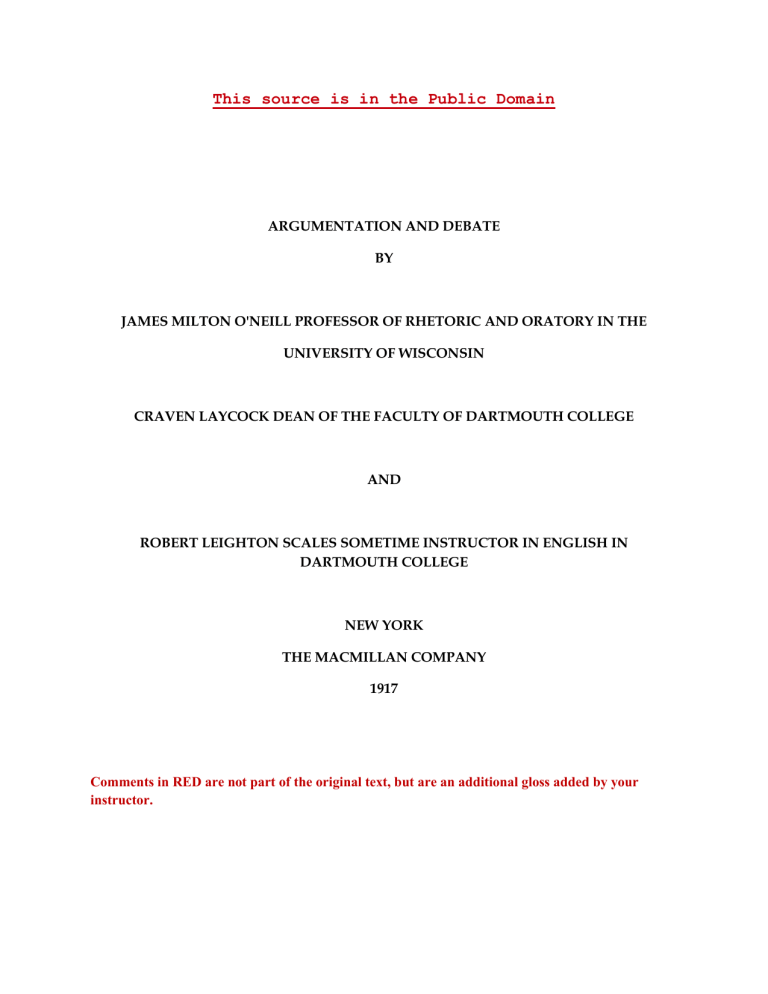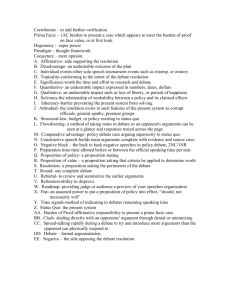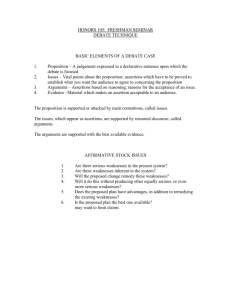O'Neill Characteristics of Good Propositions

This source is in the Public Domain
ARGUMENTATION AND DEBATE
BY
JAMES MILTON O'NEILL PROFESSOR OF RHETORIC AND ORATORY IN THE
UNIVERSITY OF WISCONSIN
CRAVEN LAYCOCK DEAN OF THE FACULTY OF DARTMOUTH COLLEGE
AND
ROBERT LEIGHTON SCALES SOMETIME INSTRUCTOR IN ENGLISH IN
DARTMOUTH COLLEGE
NEW YORK
THE MACMILLAN COMPANY
1917
Comments in RED are not part of the original text, but are an additional gloss added by your instructor.
CHARACTERISTICS OF GOOD PROPOSITIONS FOR DEBATE
1. Assertion.
A proposition for debate should be phrased in the form of an assertion, not a question. This is necessary in order to get a clean-cut statement of the position of the affirmative.
It prevents ambiguity and makes possible an accurate placing of the burden of proof. This last part is the most important reason.
"Resolved: that the city of X should install a water system using the water of Lake A." Not, "Should the city of X use the water of Lake A?"
2. Single.
A proposition should be single, not double. The error must be avoided of combining two separate ideas in one proposition; two questions, closely akin to one another but really distinct from each other, may easily become confused and be carelessly joined together in a single statement. For example, students sometimes devise such propositions as, “Resolved: that a high protective tariff is hostile to the economic interests of the United States, and reciprocal trade relations should be established with the Dominion of Canada;” or, “Resolved: that labor unions are detrimental to industry, and they should be compelled to incorporate.” Now in each of these propositions there are two problems presented; these problems are similar in the nature of the ideas contained in them, but the issues to be determined are very different. The proofs necessary to establish the fact that labor unions are detrimental to industry are not at all the same proofs required to show that they should be compelled to incorporate; so that the attempt to combine in one demonstration what are really two distinct proofs must result in confusion. We may handle each of these questions separately, but we cannot hope to treat both successfully in one debate.
Consequently, in formulating our statements for debate, we must be sure not only to have a proposition, but to have a single proposition.
3. Unambiguous.
A proposition should be unambiguous. Avoid ambiguous, general terms capable of a number of different meanings civilization, church, progress, conservatism. Use the
most specific, most definite, most limited term possible in each case. For example, in the proposition : "Resolved: that the judiciary should be (or should not be) independent of the will of the people," what is meant by "judiciary," "independent," "the will of the people"? Until definite meanings have been agreed upon for all of these terms (and preferably substituted for the original ambiguous terms in the proposition) there can be no discussion worthwhile. The advice you find here is not absolute, but “more or less.” Language always involves ambiguity and a debate proposition, being an isolated sentence, is particularly open to being understood in different ways.
4. Unprejudiced.
A proposition should be unprejudiced. The question must not be begged by a phraseology that assumes the point to be proved. "Resolved: that the undesirable Japanese should be excluded." "Resolved: that the inefficient lecture system should be abolished."
"Resolved: that the barbarous conduct of the Bulgarian troops should be condemned." The italicised words are all question begging epithets which practically cover the point at issue.
Avoid all descriptive expressions of praise or blame. Colorless expressions which serve simply to identify or define should be used exclusively in phrasing propositions.
5. Concrete and specific.
The proposition for debate should be as concrete and specific as possible. This rule is qualified somewhat because one cannot accurately say that all propositions for debate should be concrete and specific. If the case presents for discussion an abstract or general proposition, there is no reason why such discussion should not be had, but every proposition for debate should be as concrete and specific as the circumstances of the discussion permit.
6. Burden of proof on affirmative . The burden of proof should be on the affirmative. This general principle which is universally true, should replace the rules of thumb containing half truths in regard to the negative statements and the word "not." It makes no difference whether the proposition is worded negatively or contains the forbidden word "not," so long as the affirmative of the proposition as worded has the burden of proof.
The burden of proof actually rests upon the side advocating a change, or opposing the existing order. This statement, while correct, should be broadened, because we do NOT always debate policies. In debating a Proposition of Fact, for example, there is no requirement to advocate any change. What matters is that Affirmative is placed on the more controversial side of the debate proposition. That is, Natural Presumption* should (as a general rule) be placed in favor of the
Negative when debate topics are written. The presumption is with "things as they are" whereever there is well-ordered discussion. Wherever there is debating which pays proper attention to logical sequence and economy of time and attention, the attack of the one opposing the present and advocating the new, is always advanced before the defense of the established order (or a counter proposition or remedy) is brought forward. So that in phrasing a proposition for debate, in order not to go astray on this point, the only thing that is necessary is to inquire which side is advocating the new, and opposing the existing situation; then so word our proposition that that side will have the affirmative. Often changing situations require different wordings of propositions due to the fact that the actual presumption may change from side to side with changing conditions. For instance, a few years ago the proposition "Resolved: that United States
Senators should be elected by popular vote," was well worded. Now this proposition is badly worded because the burden of proof actually lies upon the negative, and the presumption is with the affirmative. Therefore, to-day the proposition should read, "Resolved: that United States
Senators should be elected by the Legislatures of the several states," or some other wording which places the burden of proof upon the affirmative, and requires the affirmative to advocate a change from the existing order.
7. Brief and simple.
A proposition for debate should be as brief and simple as possible. This rule is also qualified because brevity and simplicity should always be sacrificed to accuracy. It sometimes happens that we are debating a proposition which deals with a situation so complex that a long and complex proposition is needed to set forth with accuracy our opinion in regard to this situation. All we can do is to strike out every superfluous word, and to have as brief and simple a statement as will allow us to say accurately what we wish to say.
8. Debatable. A proposition for debate should be debatable. By that we mean that it should be two-sided. To speak more accurately, a proposition is debatable when it is such that it permits an intelligent difference of opinion, after the important facts which underlie it have been set forth.
We must avoid propositions which should be settled by definite tests, or measurements, or investigation, rather than by discussion. For instance, do not debate the question of a horse’s weight; weigh the horse. Do not debate whether or not the price of a certain commodity has risen
25% in the last decade; refer to trustworthy reports and find out whether or not this is true. This means practically, Do not debate pure questions of fact when it is possible by investigation to determine the truth so accurately that intelligent men cannot differ after the results of the investigation become known.
Important questions of policy are practically always good questions for debate. Certain questions which are questions of fact, but which cannot be settled accurately by simple investigation, such as questions concerning the origin of the earth, the origin of life, the descent of man, etc., may
also be excellent questions for debate. Useless, of course, for the purpose of debate are all propositions stating mere personal taste or opinion which is based upon elements that are hard to weigh and measure, or which involve comparisons that must rest either upon such elements or upon simple definition. For instance:
"Resolved : that Lake Y is the most beautiful lake in America."
"Resolved: that law is a nobler profession than medicine."
"Resolved: that James Whitcomb Riley was a great poet."
An additional requirement might be added to this list, that of “scope” or “breadth.” There is a limited amount of time in an academic debate to settle the issue, so the resolution should be narrowed sufficiently so that the question can be brought to a conclusion. William Trufant Foster
(1917) elaborates on this in Argumentation and Debating :
Closing Thoughts: What you find in this document is NOT practical advice about “how to debate,” but rather information about how a debate should be staged – it all begins with the RESOLUTION. When you need to set up a friendly debate, these are rules you should follow. Your job as an Affirmative debater is to take a proposition which has been assigned to you and to State, Define, and Preserve the controversy.
Your job as a Negative debater is to make sure that you keep the Affirmative honest in performing this task.
* Natural Presumption refers to the existing state of belief in some group (regardless of how that belief relates to the real world). As the authors note, Natural Presumption changes over time. Artificial
Presumption, on the other hand, does not refer to whether or not people are inclined to believe a claim, but has to do with procedures and rules. Artificial Presumption is more concerned with a process and procedure than with any particular truth claim. In a criminal court in the United States, for example, the defendant is “presumed innocent” until “proven guilty.” Does this presumption of innocence refer to the probability that the defendant most likely did not commit the crime? Absolutely not. The accused might obviously be guilty in light of overwhelming evidence. Nevertheless, the prosecution still has to prove their case. Why? Because we are concerned that everyone gets a fair trial, even if that means some guilty people go free. We could, however, just as easily work from the assumption that the accused is guilty until proven innocent. The choice is artificial. In academic debate there has been a tendency to artificially
(i.e., as a procedural rule of the game) place the burden of proof on the Affirmative, regardless of where
Natural Presumption on the topic lies. That is, even if a topic slightly favors the Affirmative (in terms of
Natural Presumption), a judge in a debate round will typically treat the Affirmative like the prosecution in a criminal case and only award them the victory if they prove the resolution true. Things can get confusing with inexperienced judges and clever Affirmative debaters who, realizing that Natural
Presumption is on their side with a particular resolution, claim that they do not have to prove anything and that it is the Negative side which has the burden of proof. Writing debate resolutions so that presumptions is BOTH Naturally AND Artificially against the Affirmative helps prevent such things from happening.








